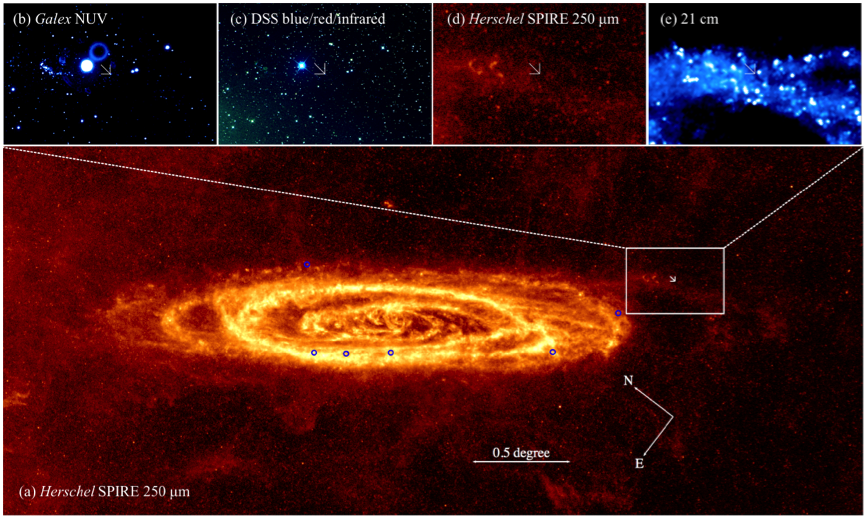云南大学中国西南天文研究所刘晓为研究团队在仙女座星系外围发现一颗亮蓝变星
Discovery of a new Luminous Blue Variable in the outskirt of the Andromeda Galaxy
近日,云南大学中国西南天文研究所刘晓为研究团队利用国家大科学装置郭守敬望远镜(大天区面积多目标光纤光谱天文望远镜,英文简称LAMOST)、中科院国家天文台2.16米望远镜、中科院云南天文台2.4米望远镜观测的数据以及历史存档数据联合证认了一颗位于仙女座星系(Andromeda Galaxy; 也称M31)外围的亮蓝变星 — LAMOST J0037+4016,这也是目前发现距M31中心最远的一颗。
炽热的亮蓝变星是大质量(初始质量通常大于25个太阳质量)恒星的演化阶段,有着极高的亮度(10^5-10^7太阳光度),位于赫罗图的左上角顶部。在亮蓝变星演化阶段,恒星通常会有间歇性的质量损失暴,此时恒星的光学波段会变亮1-2星等,光谱型从O/B型超巨星转变为A/F型超巨星。传统的大质量恒星演化模型通常认为该类恒星是大质量恒星的氦主序星,即沃尔夫-拉叶星的前身星。但近来有观测证据表明亮蓝变星可以爆炸为II型超新星。发现和证认更多亮蓝变星对于理解大质量恒星的质量损失暴及其演化模型至关重要。
此前,在M31中证认确定的亮蓝变星只有6颗,都集中在其旋臂或是恒星形成环上(如图1所示)。利用长时间的光变数据、多历元的光谱数据及近红外颜色信息,该研究团队发现并证认出了M31中的第7颗亮蓝变星,其位置非常特殊,处于M31盘最外围的一个延伸子结构上,使之成为了目前发现的距M31中心最远的一颗亮蓝变星。由于该亮蓝变星的特殊位置,对该星及其周边环境的后续观测研究将有助于对大质量恒星的演化模型提供重要的约束。
目前该研究成果已被国际专业学术期刊《天体物理学杂志通讯》(The Astrophysical Journal Letters)接受(arXiv:1909.04832)。

图1:不同波段图片下的LAMOST J0037+4016。a) Herschel SPIRE 250微米远红外图,图中蓝色圈表示M31中已知亮蓝变星位置,白色框为LAMOST J0037+4016所处位置(视场中心);b) Galex 近紫外(NUV)波段放大图像;c) DSS光学三色合成放大彩图;d)Herschel SPIRE 250微米远红外放大图;e) 21 cm波段射电放大图。放大图对应的视场大小与图a中白色框相同。Images in the different bands showing the location and environment of LAMOSTJ0037+4016. Panel a: Herschel SPIRE 250μm image. The image scale is shown near the mid-bottom. The six blue circles mark the locations of the previously known LBVs in M31. The white box of size 20’×30’ is centred at this newly discovered LBV. The four images on the top zoom in on the area (of the same size of the white box) of LAMOSTJ0037+4016 in Galex NUV band (panel b); in DSS blue, red and infrared color composite image (panel c); in Herschel SPIRE 250μm image (panel d) and in 21cm line image (panel e).

A study by the research group led by Prof. Xiaowei Liu (刘晓为) from the South-Western Institute for Astronomy Research (SWIFAR) at Yunnan University reports the discovery of a new Luminous Blue Variable (LBV) in the outskirt of the Andromeda Galaxy (M31), using data from the LAMOST spectroscopic surveys, from the Xinglong NAOC 2.16m and Lijiang YNAO 2.4 m optical telescopes, as well as archival data. The finding has been accepted for publication by The Astrophysical Journal Letters (Huang et al. 2019; arXiv: 1909.04832).
LBVs are hot, unstable, massive (> 25 – 30 solar mass) and extremely luminous (105 – 107 solar luminosity) evolved stars in the upper left parts of the Hertzsprung-Russell (HR) diagram. During the LBV phase, massive stars undergo episodes of eruptive mass-loss (10-5 – 10-4 solar mass per year), accompanied by spectacular photometric and spectral variabilities, on timescales of years to decades or longer. The origin of the eruptions is not yet well understood, partly due to the limited number of confirmed LBVs and the rareness of the eruptions. From the quiescence to the outburst (or eruptive) stage, the brightness of an LBV increases by 1 – 2 mag in the visual band and the spectrum type changes from O/early-B to A/F.
At present, the LBV is either considered as a transition phase between the main sequence massive stars and the Wolf-Rayet stars or is an intermediate precursor of a supernova. More recently, some studies show evidence propose that LBVs could be evolved blue stragglers, i.e. the products of binary evolution, although this is still hot debated. Discovery of new LBVs is therefore of vital importance for understanding the origin of the eruptions and the role LBVs play in stellar evolution.
Currently, only six LBVs are identified and all of them are located in the spiral arms or star forming rings of the M31 disk (see Fig. 1). Using the optical light curve, the multi-epoch spectra and the near-infrared color-color diagram, we have identified the seventh LBV of M31. More interestingly, this new LBV is located near the south-western corner of M31 with an unexpectedly large projection distance of 22 kpc from the center. Follow-up observations of this special LBV and its environment may provide vital constraints on the evolutionary status of LBVs.
